MIHO's Healthy Smile Life
from webWD

歯科用ハードウェア(装置)のビジュアルガイド
A Visual Guide to Dental Hardware
https://www.webmd.com/oral-health/ss/visual-guide-dental-hardware
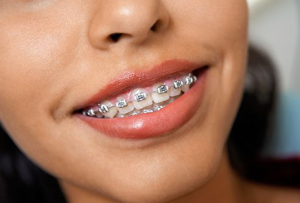
Braces
Braces are the first choice of many orthodontists to straighten teeth and fix faulty bites. They can be made of metal, ceramic, or clear plastic. Some are bonded to your teeth. Others are removable. You may have them put on a group of teeth or all of your teeth.
url
Traditional braces are attached using a system of brackets, wires and, in some cases, elastic bands. All braces put tension on your teeth to realign them.
ブレース
歯列矯正装置は、歯を矯正し、不正な咬合を修正するために多くの矯正歯科医がまず選択するものです。 それらの素材は、金属、セラミック、または透明なプラスチックなどです。それらの装置は歯に接着して使用します。 その他取り外しが可能なものもあります。 いくつかの歯の部分的なところ、または全ての歯に装着するものです。
従来のブレースは、ブラケット、ワイヤー、場合によってはゴムバンドなどがシステムとなって使用されます。 すべてのブレースは、歯に弱い力をかけながら動かしていきます。

Headgear
It may look medieval, but orthodontic headgear has been around only since the early 20th century. It’s a key fixture in some treatments to guide the face and jaws. The gear slips over the back or your head and attaches to your braces thanks to a wire in front of your teeth called a facebow or archwire. The tension the headgear pulls things into proper alignment.
url
If you need it, you’ll usually wear it for several hours at a time.
ヘッドギア
中世のものに思われるかもしれませんが、 歯列矯正用ヘッドギアの出現は20世紀初頭以降です。ヘッドギアは、いくつかの治療法において顔やあごを正しく導くための重要な装置です。ギアは、後方か頭の方からかぶって簡単に装着でき、フェイスボウまたはアーチワイヤと呼ばれる歯の前にあるワイヤーが連結している矯正装置(ブレース、ブラケット)に取り付けることができます。ヘッドギアに力をかけることで、歯列を正しい方向に引っ張ります。 必要な場合は、通常数時間は装着し続けなければなりません。
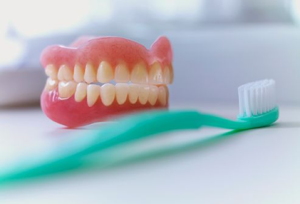
Dentures
More than 1 in 4 Americans age 65 and over are toothless. The answer? Dentures. False teeth are attached to a plate. Dentures can either sit on the gums, snap on posts implanted into the gum and jaw, or in newer cases, be screwed into implants. They can be full, replacing all the teeth, or partial, replacing just some.
url
義歯
65歳以上のアメリカ人の4人に1人以上は歯がありません。では、どうすると思いますか? 答えは義歯を使うのです。偽歯がプレートに取り付けられています。義歯は歯茎にのせるか、歯茎と顎に植え込まれた支柱にはめ込むか、最新のものは、インプラントにねじ込むことができます。全ての歯を義歯にする、部分的に義歯にする、何本かを義歯に取り替えるなど種類は豊富です。
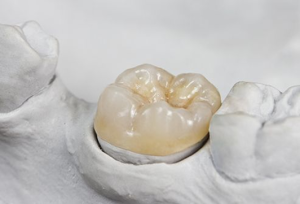
Inlays / Onlays
Inlays are sometimes called amped-up fillings. They make up for tooth surface lost to decay or some other reason. They’re formed to the teeth and used to be gold. Now, they can be made of ceramic or a composite and made to match the color of your teeth more closely.
Onlays are similar, but they spill onto the outside surface of the teeth. They’re also ceramic or composite.
url
インレー/アンレー
インレーは、充填された詰め物と呼ばれることがあります。虫歯やその他の理由が原因で、歯の表面を埋め合わせることです。歯の型に形成されますし、かつては金で作られていました。現在は、セラミックや複合材料(コンポジット)で作成することができ、より自分の歯の色に合わせて作ることができます。
アンレーも似ていますが、それらは歯の外側表面にはみ出します。それらの素材もセラミックか合成物(コンポジット)です。
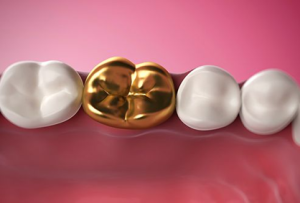
Crowns
Crowns and caps are basically the same thing — coverings for teeth. They’re used when the original tooth is damaged, weak, doesn’t fit well with your other teeth, is discolored, or needs to make room for a bridge.
Crowns strengthen the tooth and improve its appearance. They can be made of many materials in a number of shades.
url
クラウン
クラウンとキャップは基本的に同じものです – 歯を全体に覆うものです。クラウンは、元の歯が傷んでいる、弱い、他の歯とうまく合わない、変色している、またはブリッジのためのスペースを作る必要があるときに使用されます。
クラウンは歯を強化し、見た目を向上させます。色合いを選べたり、様々な材料から作ることができます。
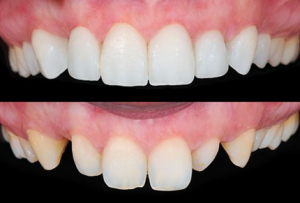
Veneers
Unlike caps and crowns, which cover the whole tooth, veneers are thin pieces of a ceramic-type material that cover just the front of your teeth. They’re good for hiding broken, chipped, or stained teeth and can be
fitted to cover gaps.You can’t take them off. They’re bonded on permanently.
url
べニア
キャップやクラウンのように 歯全体を覆うのではなく、べニアは、歯の表面だけを覆うセラミックタイプの薄い素材です。壊れて欠けている歯、または色素沈着の歯や隙間を埋めるために装着することができます。
永久的に結合していますので、自分で外すことはできません。
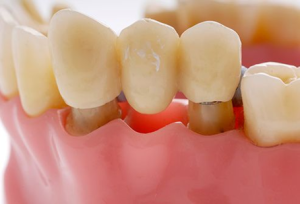
Bridges
These close the gap created by a missing tooth. Often, the teeth on either side of the gap, called the abutment teeth, have to be ground down. They’re fitted with crowns, and then the bridge — usually two crowns that fit over the abutment teeth and a false tooth attached to the crowns — is placed and bonded to the site. It can work for more than one tooth, too.
url
ブリッジ
ブリッジは、欠損歯によって生じた隙間を埋めます。多くの場合、隙間にある支台歯と呼ばれるどちらかの歯は、研削する必要があります。
クラウンが取り付けられた後、ブリッジ(通常は支台歯にフィットする2つのクラウンと、クラウンに取り付けられた入れ歯)が配置され接着されます。複数の歯にも使用できます。
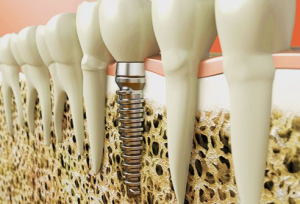
Implants
Another way to replace a missing tooth (or many) is through implants. They’re false teeth that don’t slip over the gum or aren’t bridged with other teeth. They’re anchored to your jaw.
A titanium post is surgically inserted into the jaw, an extension called an abutment is attached to the post, and a crown tops things off.
url
The process takes weeks because bone has to regrow around the post.
インプラント
欠損した歯の代わりとなるもう1つの方法は、インプラントによるものです。歯茎にすっぽりかぶせたり、他の歯にブリッジをしない偽のものです。インプラントはあごに固定されています。
チタン製の支柱が顎に外科手術で挿入され、支台歯と呼ばれる延長部が支柱に取り付けられ、冠で覆います。 骨が支柱の周りで再生しなければならないので、プロセスは数週間かかります。
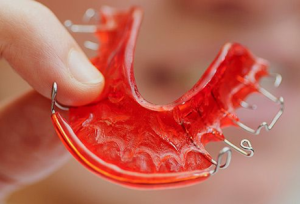
Retainers
Think of these as backups for your braces. They’re often used once your braces are off to keep your teeth from moving back. Made out of plastic, with wires that attach to your teeth to hold it in place, retainers are usually worn at night, though at first your dentist may tell you to wear them 24/7.
Your orthodontist may suggest a lingual, or tongue-side retainer. That’s a permanent wire that’s bonded to the inside of your teeth.
url
リテーナー
リテーナーは、ブレースの保定と考えてください。ブレースが外されると、歯列が後戻しないように使われます。プラスチック製で、歯列をしっかりと固定するために、歯に接触するようにワイヤーがついています。リテーナは通常夜間に着用します。最初に歯科医はリテーナーを毎日7時間着用するように伝えるでしょう。歯科矯正医は、舌側リテーナーを提案するかもしれません。それは歯の内側に接着されている半永久的な固定ワイヤーです。
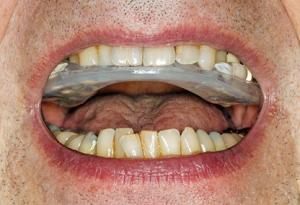
Occlusal Guards
These aren’t mouth guards like athletes wear. These guards, also called splints, are used at night to keep you from damaging your teeth when you grind them and to relieve temporomandibular joint (TMJ) pain.
A dentist or your orthodontist will fit you with one. They’re usually made of plastic-type material.
url
咬合ガード
アスリートが着用するようなマウスガードではありません。 スプリントとも呼ばれるこれらのガードを就寝時に装着することで、 歯ぎしりによってあなたの歯が傷つけられるのを防ぎ、顎関節(TMJ)の痛みを和らげます。
歯科医または歯科矯正医があなたに合うものを選んでくれます。マウスガードは、通常プラスチックの材料でできています。
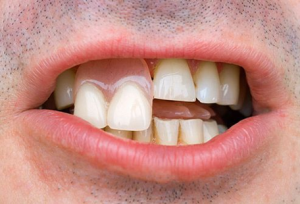
Flippers
A flipper is a temporary tooth attached via a plate (like a denture) or wires (kind of like a bridge). It has that name because you can easily flip it in and out.
url
You can have more than one or a set. They fill a hole before something more permanent (like a bridge, denture, or an implant) takes over. Some like them so much, though, and they’re so comparatively cheap that they become long-term plugs.
フリッパー(仮の歯 仮歯 テック 暫間歯)
フリッパー(ひれ状のもの)とは一時的な歯のことで、 プレート(義歯のようなもの)を介して、 またはワイヤー(ブリッジの一種)を介して取り付けられています。 その名前は 、簡単に取り外しすることができるところからきています。永久的なもの(ブリッジ、義歯、インプラントなど)を入れる前に穴をふさぐ目的で採用されることもあります。フリッパーを大変気に入る方もいますし、比較的安価なので長期的に使用も可能です。
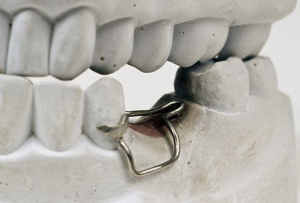
Space Maintainers
Mostly used with kids who lose a baby tooth, “spacers” keep the spot open where the tooth was until a permanent tooth arrives. They’re normally a fixed, sturdy wire that stretches from one tooth to another, ensuring that those teeth don’t migrate into the empty spot.
Occasionally, a space maintainer is used until a false tooth is fitted, and once in a while they’re used to leave a space permanently open.
url
スペースメンテナー
乳歯を失った子どもが主に使用します。 永久歯が生えてくるまで、 「スペーサー」が欠損した歯の空間を広げたままの状態で保っておくことができます。通常、それは歯から歯へと伸びる固定された頑丈なワイヤーで、その歯が、空間になっている場所に移動しないようにします。
場合によっては、入れ歯が装着されるまでスペースメンテナーが使用され、永久にスペース開いたままにさせるために使用されることもあります。
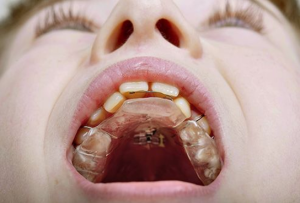
Palatal Expander
These metal devices are generally for kids. They widen your upper jaw and palate so teeth don’t get too crowded and your upper jaw fits better with your lower one.
The device, also called a rapid palatal expander, puts pressure on the upper teeth, spreading the still-growing palate to the desired width. The expander, which sits on the palate and presses metal plates against the teeth, is adjusted with a type of key.
url
パラタルエキスパンダー (口蓋拡張装置)
これらの金属製装置は一般に子ども用です。 上顎と口蓋を拡大させるので、歯が混みあって生えることを防ぎ、上顎と下顎がよりよくフィットするように誘導します。急速口蓋拡張装置とも呼ばれる装置は、上の歯に圧力をかけ、まだ成長している口蓋を期待する幅に広げます。口蓋の上に取り付けて歯に金属板を押し付けるエキスパンダーは、適合するキーで調整されます。

